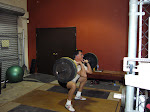Wednesday, October 17, 2012
Back to the beginning!
When first considering what you do after back surgery following physical therapy must get good direction from someone who has had the surgery you had and had the issues you have. Bad backs normally have a few things in common. One, poor core strength. Two, normally the person with the bad back does not move properly. Proper movement patterns also known as movement efficiency is the key to decreasing your risk for back injury. Core strength and proper movement patterns are not hard to learn but they must be directed by somebody who knows them intimately. This is why I would recommend myself or any of the people I have spoken of in this blog to help you regain that independence you once had. At this time I will go over a few exercises that you could find on the Internet examples of which should give you a good idea as to what people are talking about when they talk about core work. Learning how to execute a bridge or a plank could be the difference between back pain and full dynamic movement without any pain. Now movement pattern that is often spoken about in terms of reducing back injury risk is the hip hinge. This is an easy movement to learn especially for those who have had any kind of dance or athletic jumping background. The key is the pelvic tilt. The pelvic tilt is controlled by a number of muscles wanted particular is the psoas.The psoas is a long strong muscle that attaches near the top of the femur and then the lateral anterior aspects of the lumbar spine. This muscle often becomes shortened and weakened due to sitting all day long. The hip hinge is performed by placing a dowel four feet long behind the head and running along the spine to the buttocks. The dowel should remain in contact with the back of the head spine between the shoulder blades and the SI joint at the base of the spine as you flex your hips and your knees. This is the hip hinge simple but some people just have trouble in this motion. Practice this and it will go a long way in decreasing low back discomfort.
Subscribe to:
Post Comments (Atom)

No comments:
Post a Comment